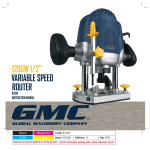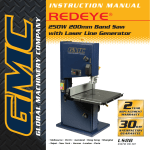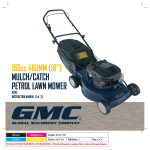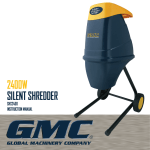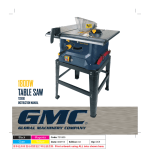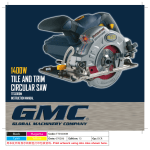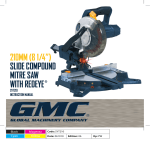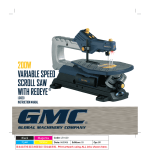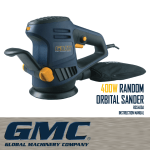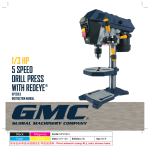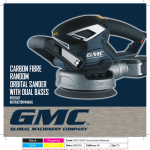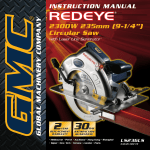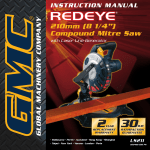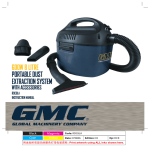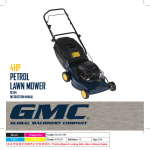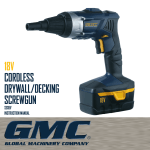Download Global Machinery Company SPJ2HM User's Manual
Transcript
710W SCROLLING PENDULUM ACTION JIGSAW SPJ2HM INSTRUCTION MANUAL 1 Black Cyan Magenta Yellow Code: SPJ2HM IM Date: 070207 Edition: 12 Op: AB Contents Warranty Introduction Environmental protection Description of symbols Specifications Safety instructions Additional safety rules for jigsaws Accessories Unpacking Know your product Trigger switch Blade guard Blade Guide Anti splintering insert Changing a blade Blade storage Pendulum adjustment Scrolling control Angle adjustment Variable speed dial Barel mode Parallel guide Laser sighting Safety Dust control Operation Maintenance Cleaning General inspection Warranty Power Tools 2 3 3 3 3 4 5 6 6 7 8 8 8 8 9 9 9 10 10 11 11 11 11 12 12 12 14 14 14 Whilst every effort is made to ensure your complete satisfaction with this tool, occasionally, due to the mass manufacturing techniques, a tool may not live up to our required level of performance and you may need the assistance of our service department. This product is warranted for a 2-year period for home domestic use from the date of the original purchase. If found to be defective in materials or workmanship, the tool or the offending faulty component will be repaired or replaced free of charge with another of the same item. A small freight charge may apply. Proof of purchase is essential. We reserve the right to reject any claim where the purchase cannot be verified. This warranty does not include damage or defects to the tool caused by or resulting from abuse, accidents, alterations or commercial or business use. It also does not cover any bonus items or included accessories. Only the power tool is covered under this warranty. With continuing product development, changes may have occurred which render the product received slightly different to that shown in this instruction manual. Please ensure that you store your receipt in a safe place. Conditions apply to the above warranty. For full details of the warranty terms and conditions please refer to our website – www.gmcompany.com For prompt service we suggest you log your service request online - www.gmcservice.com.au, should you not have access to the internet, please contact our service department on 1300 880 001 (Australia) or 0800 445 721 (New Zealand). 2 Introduction Description of symbols Your new GMC power tool will more than satisfy your expectations. It has been manufactured under stringent GMC Quality Standards to meet superior performance criteria. You will find your new tool easy and safe to operate, and, with proper care, it will give you many years of dependable service. CAUTION. Carefully read through this entire Instruction Manual before using your new GMC Power Tool. Take special care to heed the Cautions and Warnings. Your GMC power tool has many features that will make your job faster and easier. Safety, performance, and dependability have been given top priority in the development of this tool, making it easy to maintain and operate. The rating plate on your tool may show symbols. These represent important information about the product or instructions on its use. Wear hearing protection. Wear eye protection. Wear breathing protection. Double insulated for additional protection. For safe operation read instruction manual. Conforms to relevant standards for electromagnetic compatibility. Specifications Environmental protection Recycle unwanted materials instead of disposing of them as waste. All tools, hoses and packaging should be sorted, taken to the local recycling centre and disposed of in an environmentally safe way. Voltage: 230–240V ~ 50Hz Power input: 710W No load speed: 800–3000min-1 Stroke length: 23mm Cutting angle range: ±45° Cutting capacity in: Wood: 100mm Steel: 6mm WARNINGS 1. It may be more difficult to see the laser line in conditions of bright sunshine and on certain surfaces. 2. When storing the tool, remove the batteries in case of leakage. 3. Batteries or damage due to leaking batteries are not covered under warranty. Blade types: “T” & “U” Shank Net weight: 3.3kg Laser: Class 2 Wave length: 650nm Output power: ≤1mW Sound Pressure Level: 95 dB(A) Sound Power Level: 106 dB(A) Vibration: 6.27m/s2 Be aware noise levels can increase due to the work environment. Always wear effective ear protection when noise levels are above 85 dB(A). 3 Safety rules for laser lights General safety rules The laser light/laser radiation used in the GMC REDEYE® system is Class 2 with maximum 1mW power and 650nm wavelength. These lasers do not normally present an optical hazard, although staring at the beam may cause flash blindness. WARNING. Do not stare directly at the laser beam. A hazard may exist if you deliberately stare into the beam, please observe all safety rules as follows; • The laser shall be used and maintained in accordance with the manufacturer’s instructions. • Never aim the beam at any person or an object other than the work piece. WARNING. Read all instructions. Failure to follow all instructions listed below may result in electric shock, fire and/or serious injury. The term “power tool” in all of the warnings listed below refers to your mains operated (corded) power tool or battery operated (cordless) power tool. Save these instructions 1. Work area a. Keep work area clean and well lit. Cluttered and dark areas invite accidents. b. Do not operate power tools in explosive atmospheres, such as in the presence of flammable liquids, gases or dust. Power tools create sparks which may ignite the dust or fumes. c. Keep children and bystanders away while operating a power tool. Distractions can cause you to lose control. 2. Electrical safety a. Power tool plugs must match the outlet. Never modify the plug in any way. Do not use any adapter plugs with earthed (grounded) power tools. Unmodified plugs and matching outlets will reduce risk of electric shock. b. Avoid body contact with earthed or grounded surfaces such as pipes, radiators, ranges and refrigerators. There is an increased risk of electric shock if your body is earthed or grounded. c. Do not expose power tools to rain or wet conditions. Water entering a power tool will increase the risk of electric shock. d. Do not abuse the cord. Never use the cord for carrying, pulling or unplugging the power tool. Keep cord away from heat, oil, sharp edges or moving parts. Damaged or entangled cords increase the risk of electric shock. LASER LIGHT. LASER RADIATION Do not stare into beam. Class 2 laser product. Wavelength: 650nm Output power: ≤1mW AS/NZS 2211-1:2004 • The laser beam shall not be deliberately aimed at personnel and shall be prevented from being directed towards the eye of a person for longer than 0.25s. • Always ensure the laser beam is aimed at a sturdy work piece without reflective surfaces. i.e. wood or rough coated surfaces are acceptable. Bright shiny reflective sheet steel or the like is not suitable for laser use as the reflective surface could direct the beam back at the operator. • Do not change the laser light assembly with a different type. Repairs must only be carried out by the laser manufacturer or an authorised agent. CAUTION. Use of controls or adjustments or performance of procedures other than those specified herein may result in hazardous radiation exposure. Please refer to the relevant Australian standards, AS 2397 and AS/NZS2211 for more information on Lasers. 4 e. When operating a power tool outdoors, use an extension cord suitable for outdoor use. Use of a cord suitable for outdoor use reduces the risk of electric shock. 3. Personal safety a. Stay alert, watch what you are doing and use common sense when operating a power tool. Do not use a power tool while you are tired or under the influence of drugs, alcohol or medication. A moment of inattention while operating power tools may result in serious personal injury. b. Use safety equipment. Always wear eye protection. Safety equipment such as dust mask, non-skid safety shoes, hard hat, or hearing protection used for appropriate conditions will reduce personal injuries. c. Avoid accidental starting. Ensure the switch is in the off position before plugging in. Carrying power tools with your finger on the switch or plugging in power tools that have the switch on invites accidents. d. Remove any adjusting key or wrench before turning the power tool on. A wrench or a key left attached to a rotating part of the power tool may result in personal injury. e. Do not overreach. Keep proper footing and balance at all times. This enables better control of the power tool in unexpected situations. f. Dress properly. Do not wear loose clothing or jewellery. Keep your hair, clothing and gloves away from moving parts. Loose clothes, jewellery or long hair can be caught in moving parts. g. If devices are provided for the connection of dust extraction and collection facilities, ensure these are connected and properly used. Use of these devices can reduce dust related hazards. 4. Power tool use and care a. Do not force the power tool. Use the correct power tool for your application. The correct power tool will do the job better and safer at the rate for which it was designed. b. Do not use the power tool if the switch does not turn it on and off. Any power tool that cannot be controlled with the switch is dangerous and must be repaired. c. Disconnect the plug from the power source before making any adjustments, changing accessories, or storing power tools. Such preventive safety measures reduce the risk of starting the power tool accidentally. d. Store idle power tools out of the reach of children and do not allow persons unfamiliar with the power tool or these instructions to operate the power tool. Power tools are dangerous in the hands of untrained users. e. Maintain power tools. Check for misalignment or binding of moving parts, breakage of parts and any other condition that may affect the power tools operation. If damaged, have the power tool repaired before use. Many accidents are caused by poorly maintained power tools. f. Keep cutting tools sharp and clean. Properly maintained cutting tools with sharp cutting edges are less likely to bind and are easier to control. g. Use the power tool, accessories and tool bits etc., in accordance with these instructions and in the manner intended for the particular type of power tool, taking into account the working conditions and the work to be performed. Use of the power tool for operations different from those intended could result in a hazardous situation. 5. Service a. Have your power tool serviced by a qualified repair person using only identical replacement parts. This will ensure that the safety of the power tool is maintained. Additional safety rules for jigsaws WARNING. Before connecting a tool to a power source (mains switch power point receptacle, outlet, etc.) be sure that the voltage supply is the same as that specified on the nameplate of the tool. A power source with a voltage greater 5 than that specified for the tool can result in serious injury to the user, as well as damage to the tool. If in doubt, do not plug in the tool. Using a power source with a voltage less than the nameplate rating is harmful to the motor. Your tool is double insulated for additional protection against a possible electrical insulation failure within the tool. Always remove the plug from the mains socket before making any adjustments or maintenance, including changing the blade. • Ensure that the lighting is adequate. • Do not use the saw unless the guards are in place • Keep the shoe flat on the work piece. • Do not put pressure on the saw, such that it slows the motor down. Allow the saw blade to cut without pressure. You will get better results and you will be taking better care of your tool. • Keep the area free of tripping hazards. • Do not let anyone under 18 years operate this jigsaw. • Only use blades in good condition. • Before cutting, check that there is sufficient clearance for the blade under the work piece. • Do not touch the blade after operation. It will be very hot. • Keep your hands away from under the work piece. • Never use your hands to remove sawdust, chips or waste close by the blade. • Rags, cloths, cord, string and the like should never be left around the work area. • Avoid cutting nails. Inspect the work piece and remove all nails and other foreign objects before beginning sawing. • Support the work properly. • Never reach over the blade to remove waste or off cuts. • Do not attempt to free a jammed blade before first switching off the machine. • If you are interrupted when operating the saw, complete the process and switch off before looking up. • Periodically check that all nuts, bolts and other fixings are properly tightened. • Do not store materials or equipment above a machine in such a way that they could fall into it. • Always hold the saw on parts that are insulated. If you accidentally cut into hidden wiring or the saw’s own cable, the metal parts of the saw will become ‘live’. • Do not secure the jigsaw upside down in a vice or work bench and use it as a saw bench. This can lead to serious injury. • When using the jigsaw, use safety equipment including safety goggles or shield, ear defenders, dust mask and protective clothing including safety gloves. Accessories The SPJ2HM is supplied in a storage case with the following accessories: • 5 x Wood cutting blades • Parallel guide • Dust extraction adaptor • Anti splintering insert • Hex key Unpacking Due to modern mass production techniques, it is unlikely that your GMC Power Tool is faulty or that a part is missing. If you find anything wrong, do not operate the tool until the parts have been replaced or the fault has been rectified. Failure to do so could result in serious personal injury. Assembly The GMC jigsaw is packed, fully assembled except for the blade. 6 Know your product 1. Trigger switch 2. On / off switch 3. Lock-on button 4. Scrolling control knob 5. Pendulum lever (scrolling lock) 6. Blade guard 7. Blade guide 8. Variable speed dial 9. Removable handle 10. Handle release catch 11. Handle locating pin 13 (not visible) 12. Combined laser light / 6 LED switch 17 13. Laser aperture 14. Dust extraction port 21 15. Dust extraction adaptor 7 16. Cutting angle scale 17. Tool free blade change control 18. Shoe plate 19. Bevel locating pin (not visible) 20. Parallel guide 21. Parallel guide locking knob 22. Jigsaw blades 23. Anti splintering insert 24. Blade storage area (x 2) 25. Blade storage release tab (x 2) 26. Hex key 12 4 1 3 9 10 8 23 18 26 5 23 7 16 2 14 24 20 25 15 15 22 Trigger switch Blade guard Note. The trigger switch is only used in the conventional jigsaw mode, when the A removable handle is fitted. Pull up on the trigger switch (1) to turn the jigsaw on. To turn off the tool, release the trigger switch (fig A). CAUTION. Allow the blade to come to a complete standstill before setting the jigsaw down. Lock-on button B Note.The lock-on button eliminates the need to hold the trigger switch (1) on during prolonged operation. With the trigger engaged in the “on” position, push in the lockon button (3) to lock the trigger switch “ON” (fig B). To release the lock-on, engage and release trigger switch (1). On/off switch C Note. The on/off switch (2) is used only in the barrel saw mode, when the removable handle (9) has been taken off the jigsaw. Push the on/off switch (2) forward and up over the latching ramp to lock the switch on (fig C). D To turn off the tool, press the back of the switch and lift it over the latching ramp (fig D). CAUTION. Allow the blade to come to a complete standstill before setting the jigsaw down. The blade guard (6) should always be in position when operating the jigsaw. It can be removed to allow easier access when changing blades (fig E). E Blade guide The grooved disc blade guide (7) is spring loaded so that it can F accomodate varying jigsaw blade widths. It supports the back edge of the blade, keeping it running straight and helping to prevent the blade from bending which improves the accuracy of the cut and reduces the chance of blade breakage (fig F). Note. Depending on the position of the pendulum lever, the blade guide remains stationary (non-pendulum) or oscillates backwards and forwards, causing the blade to cut with a pendulum action. Anti splintering insert Because jigsaws cut on the up stroke, the top layer of wood, particularly plywood, tends to tear and splinter thus obscuring the line of the cut and causing a rough edge. The splinter insert supports the wood fibres on the top layer of the workpiece and greatly reduces the splintering effect. 1. With the power off, slide the anti splinter insert (23) up to the jigsaw blade (fig Ga & Gb). Ensure the jigsaw’s pendulum lever (5) is switched to zero (ie. Position 1). 8 Ga Gb Ha Release the blade change control (17) to secure the blade firmly in place. Reposition the blade guard (6). J Replace the plug and run the jigsaw under no load to check that it runs smoothly and the blade is secure before using it to cut any materials. Hb Blade storage 2. With a blade fitted move the variable speed dial (8) to number 3 (low speed). 3. Apply pressure to the front of the anti splinter guard on the edge of a work surface until it is flat with the front edge of the shoe plate (18) (fig Ha & Hb). To gain access to the blade storage areas (24), open the release tabs (25) located at each corner of the rear of the shoe plate (18) (fig J). Changing a blade K Pendulum adjustment Note. This jigsaw is fitted with a tool-free mechanism for fast and simple “T” and “U” shank blade removal and fitting. WARNING. Always ensure that the saw is switched off and plug is removed from the power point before changing blades or making any adjustments. Removing the blade I Remove the blade guard (6) to afford better access to the blade clamp. Push the tool-free blade change control (17) upwards towards the top of the jigsaw, making sure that your fingers do not contact the teeth of the blade (fig I). With the blade change control (17) in its uppermost position, remove the blade by pulling it downwards towards the base of the jigsaw. Refitting a new blade Push the blade change control (17) to its uppermost position and slide the new blade into the locating groove in the blade clamp with the teeth pointing forward. Make sure that the back of the blade is located and supported by the blade guide (7) (fig I). Note. The blade can be set to produce a front to rear swinging (pendulum) action when cutting. This can increase the jigsaws cutting efficiency, depending on the material being cut. L The pendulum action is functional on pendulum lever positions 1, 2 & 3 – the higher the setting the greater the pendulum action. Note.Increasing the swing of the pendulum action results in a rougher finish to the cutting edge. The scrolling control knob (4) must be positioned forward (with the arrow on the scrolling knob and jigsaw housing aligned) before the pendulum can be engaged (fig K). Rotate the pendulum lever (5) (fig L) to the position that best suits the job, as follows: Position S. SCROLLING – for the cutting of all materials and with manual 360° rotation of the blade using the scrolling controlling knob (4). Position 0. SMOOTH - for cutting mild steel / soft materials / all materials with normal up and down blade motion with minimal splintering. 9 Position 1. LOW – Minimal pendulum action for cutting most metal. Position 2. MEDIUM – Medium pendulum action for cutting plastics, and hardwoods. Position 3. FAST – Maximum pendulum action for the highest orbital action and faster cutting in plywood and soft woods. The pendulum lever (5) can now be moved to the required position for straight, standard or pendulum cutting (fig P). P Angle adjustment Note. The jigsaw shoe can be angled to enable bevel or chamfer cuts. There are preset bevel settings at 0° and 45° for quick adjustment. Always ensure the tool is switched off and the plug is removed before carrying out any adjustments or maintenance procedures. With the jigsaw upside down Q on a solid surface loosen the hex screw located on the underside of the tool using hex key (26) (fig Q). Move the shoe plate slightly back. It can now be tilted to the required angle (between 0° and 45°) as indicated on angle scale (16) (fig R). R With the shoe plate inclined at 45° left or right, or at 0°, the plate can be locked at one of these angles by sliding the shoe plate forwards so that the indentation in the bridge of the sole plate fits over the bevel locating pin (19). To secure the sole plate at a particular angle, retighten the hex screw. Scrolling control Note. The scrolling feature allows the blade to be rotated 360° for maximum blade control when cutting curves and intricate work. Ensure you use a blade M specifically intended for curve cutting (eg. scroll cutting blade). Do not place excess force when turning the blade as it may break. Set the pendulum lever (5) to Position “S” (fig M). Note. The scrolling feature will not operate if the lever is N positioned at 0,1,2 or 3. During operation place one hand firmly on the hand grip, place your other hand on the scrolling control knob (4) and rotate it - using it to guide the blade along your cutting line (fig N). To disengage the scroll function, to enable standard or pendulum O action cutting, rotate the scrolling control knob (4) back to the forward position (with the arrows on the scrolling control and jigsaw housing aligned) (fig O). 10 To refit the handle, slide the handle into position with the handle locating pin (11) in the slot at the back of the jigsaw housing. Push it fully forward until the handle release catch (10) locks positively into position (fig V). Note. When not in use, store the handle in the carry case for safe keeping. Note. For accurate work it is necessary to do a practise cut first. Check the cut and reset the angle until the correct cut is achieved. Variable speed dial Note. Adjusting the speed to suit the application enhances cutting performance and saves the blade from undue wear. To determine optimum cutting speed, first perform test cuts on offcuts of the workpiece. Rotate the dial (8), located at the back of the jigsaw to set the blade speed (fig S). Position “1” denotes the lowest speed. Position “6” denotes the highest speed. S Parallel guide Note. Use of parallel guide (20) permits accurate parallel cuts, from an edge, without the need to mark and follow a pencil line. The parallel guide can be used on the left or the right of the blade. Locate the parallel guide locking knob (21) on the side that the fence will be used. With the parallel guide locking knob (21) loosened, slide the guide (20) into the mounting slots on the shoe plate, from either the left or right hand side (fig W). Slide the fence to the required cut width and tighten the locking knob to secure the fence in position (fig X). Barrel mode Note. The handle (9) can be removed to allow the tool to be operated as a barrel jigsaw. This permits better control when using the scroll function and when cutting non-horizontal workpieces (fig T). To remove the handle (9) first grip the handle with the rear of the saw to the front. Then use your thumb to lift the handle release catch (10) and simultaneously pushing the handle towards the rear of the saw. The handle will slide backwards and can be removed from the tool (fig U). T U V W X Laser sighting Using the REDEYE® laser line system Laser light assembly The laser light is powered from a transformer housed within the assembly. The REDEYE® laser line can be used for improved operator cutting vision, accuracy of cut, faster setup and increased safety of operation. 11 To use the laser wait until you have commenced cutting then set the laser light on/off switch (12) to the on position. Maintain alignment of the beam and your cut line while slowly feeding the jigsaw through the cut. Combined laser light/ Y LED switch This jigsaw is fitted with two forms of lighting to assist in maintaining accurate alignment with the cut line. Both can be switched on and off using switch (12). See fig. (Y). Move switch (12) to the top position to activate the laser beam. Move it to the bottom position to activate the LED light. The mid position switches off both forms of lighting. • Use the laser to assist in aligning the blade with the cut line during operation. • The LED worklight produces broader lighting and is better used in low-lit conditions. Laser aperture When the REDEYE® laser line is switched on, an intense narrow beam of pure red light is emitted from the laser aperture (13). The line shines along the work piece to guide you as you cut. The line is clearly visible and will not be obscured by sawdust. WARNINGS • Do not stare directly at the laser beam. • Never aim the beam at any person or an object other than the workpiece. • Do not deliberately aim the beam at personnel and ensure that it is not directed towards the eye of a person for longer than 0.25s. • Always ensure the laser beam is aimed at a sturdy workpiece without reflective surfaces. ie. wood or rough coated surfaces are acceptable. Bright shiny reflective sheet steel or the like is not suitable for laser use as the reflective surface could direct the beam back at the operator. • Only turn laser beam on when tool is on the workpiece. Safety Eye, ear and respiratory protection should be worn at all times when using the jigsaw. Dust control Z The dust extraction adaptor (15) can be fitted to the dust extraction port (14) to allow a dust extraction system or a household vacuum cleaner to be connected to the tool in order to remove dust whilst the tool is in use (fig Z). a WARNING. Do not use a dust extraction system or a vacuum cleaner when cutting metal. Sparks may ignite residual wood dust. Note. When not being used, the dust extraction adaptor (15) can be disconnected from the jigsaw shoe by pressing down on the thumb tab and pulling it out from the shoe (fig a). Operation General cutting Note. Ensure that the blade is the correct type for the application and that the length will extend through the workpiece on the upstroke of the cut. Determine how the jigsaw is best configured for the job whether the job is best carried out with the handle on or off, scrolling function on or off or pendulum action on or off. Configure the jigsaw as required. 12 Switch on the jigsaw and allow b the blade to reach maximum speed. Slowly guide the jigsaw forward, building up speed as you go, with one hand on the handle and the other on the scrolling knob, keeping the shoe plate flat against the workpiece (fig b). Do not force the jigsaw. Use only enough pressure to keep the blade cutting. Do not force the cutting, allow the blade and the saw to do the work. Pocket & curve cutting c In order to start a cut from the centre of the workpiece, you can either drill a hole and insert the blade into the hole then start cutting, or plunge cut (fig c). When using the hole method, use a 10mm or larger drill to ensure that there is sufficient de clearance for the blade (fig d). To plunge cut, proceed as follows. Tilt the tool on the front edge of the shoe plate (18) with the point of the blade just above the workpiece (fig e). Switch on, wait for the blade to e reach maximum speed, hold the front edge of the shoe plate (18) securely against the workpiece and slowly lower the rear of the saw so that the blade penetrates the workpiece. When the shoe plate is flush with the surface of the workpiece, proceed with cutting in the normal manner. When cutting tight curves, reduce the speed of the saw. WARNING. Do not move the saw forward along its cut until the blade has completely entered the material and the shoe comes to rest on its surface. Metal cutting NOTES. • When cutting metal ALWAYS clamp down the metal workpiece. • Be extremely careful to move the saw very slowly as you cut. Use slower speeds (Position 1 on the speed controller). DO NOT twist, bend or force the blade. • When cutting metals, a suitable cooling/cutting oil must be used. Squirt the lubricant onto the blade or workpiece at regular intervals during cutting in order to reduce wear on the blade. • If the saw jumps or bounces as you cut, change to a blade with finer teeth. • If the blade begins to clog when cutting soft metal, change to a blade with coarser teeth. • For easier cutting, lubricate f the blade with a stick of cutting wax (if available) or cutting oil when cutting steel (fig f). • Thin metal should be sandwiched between two pieces of wood or tightly clamped on a single piece of wood (wood on top of the metal). Draw the cut lines or design on the top piece of wood. • When cutting aluminum extrusion or angle iron, clamp the work in a bench vice and saw close to the vice jaws. • When sawing tubing with a diameter larger than the blade is deep, cut through the wall of the tubing and then insert the blade into the cut, rotating the tube as you saw. 13 Parallel cuts g Note. Parallel cuts can be achieved using the parallel guide (20) (fig g). or by clamping a straight edge to your workpiece (fig h). Fit the parallel guide to the jigsaw shoe and position the guide against the edge of the h workpiece. Slide the jigsaw along until the blade lines up with your cut line and tighten the guide locking knob. Ensure that the guide remains evenly against the edge of the workpiece while cutting. If the guide cannot be extended enough to achieve your cut, clamp a straight batten onto the workpiece, positioning it until that the blade aligns with the cut line. Ensure the jigsaw shoe remains evenly against the batten during the cut. CAUTION. Water must never come into contact with the tool. Power cord maintenance If the supply cord needs replacing, the task must be carried out by the manufacturer, the manufacturer’s agent, or an authorised service centre in order to avoid a safety hazard. Cleaning 1. Keep the tool’s air vents unclogged and clean at all times. 2. Remove dust and dirt regularly. Cleaning is best done with a soft brush or a rag. 3. Re-lubricate all moving parts at regular intervals. 4. Never use caustic agents to clean plastic parts. CAUTION. Do not use cleaning agents to clean the plastic parts of the tool. A mild detergent on a damp cloth is recommended. General inspection Regularly check that all the fixing screws are tight. They may vibrate loose over time. Maintenance Always ensure that the tool is switched off and unplugged from the power supply before making any adjustments or carying out any maintenance procedures. Keep the tool’s air vents unclogged and clean at all times. Regularly check to see if any dust or foreign matter has entered the grills near the motor and around the switches. Use a soft brush to remove any accumulated dust. Wear safety glasses to protect your eyes whilst cleaning. Re-lubricate all moving parts at regular intervals. If the body of the tool needs cleaning, wipe it with a soft damp cloth. A mild detergent can be used but nothing like alcohol, petrol or other cleaning agent. Never use caustic agents to clean plastic parts. 14 15 GMC customer assist If your product needs repairing, replacing, technical service or you simply need help or advice, please contact us on our Customer Assist Line 1300 880 001 (Australia) or 0800 445 721 (New Zealand). For prompt service we suggest you log your service request online at www.gmcservice.com.au. Should you not have access to the Internet, please contact our service department on 1300 880 001 (Australia) or 0800 445 721 (New Zealand). 7am – 7pm, 7days a week (AEST). Please note that if repair or replacement is required, you must provide a valid original purchase receipt. You will need the following details at hand to log your service request; Personal details: First & Last name, address, pick up address, contact phone numbers, email address Product details: Product number, date of purchase, retailer bought from, State & postcode, receipt number, reason for the request, copy of official purchase receipt Attach your purchase receipt and save with this Manual for future reference. Please refer to our website www.gmcompany.com for full GMC warranty Terms and Conditions.
















